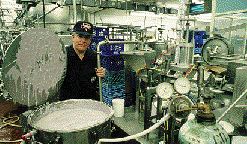By Kristen Grough
Crystallized cheese. Juiced bananas. Sparkling apple juice. Carbonated pudding. Sparkling yogurt. Wordplay. That’s how one BYU professor invents new products.
“I have this idea that you can come up with new ideas just by putting words together. You take adjectives or processes and put them on products and see what you come up with,” says Lynn Ogden, an associate professor of food science and nutrition who invented Sparkling Yogurt, a carbonated yogurt that has become a hit at BYU.
After making homemade root beer for his family, Ogden got the idea that many foods could be carbonated to add “sparkle” to the flavor.

Faculty member Lynn Ogden displays his most popular creation in process: sparkling yogurt. The Technology Transfer Office helps Ogden and other BYU inventors by marketing and licensing their ideas.
“I tried it with pudding, but the carbonation is most compatible with things that are tart. Adding sparkle to yogurt is easy,” he says. Ogden’s creation is only sold at the BYU Creamery, near the Deseret Towers student dorms. “It’s selling as well or better than the other yogurt at the creamery,” says Ogden.
But Ogden points out that he’s not a salesman; he’s an inventor. Like many BYU researchers, Ogden has a flair for creating and developing new technology, but he lacks the time and knowledge to transfer the technology to the public. Lynn Astle, director of the Technology Transfer Office, says his office offers the solution: “Our job is to market what’s developed on campus.” In the case of Ogden’s creation, Astle is working with dairy companies in Utah, Minnesota, Canada, and New Zealand that are interested in making Sparkling Yogurt.
The Technology Transfer Office not only markets ideas developed on campus, but it also helps patent, license, and introduce new technology into commercial industry. Currently, BYU has 75 active technology licenses, which generate more than $2.5 million each year. Although BYU is not a research university, it ranked 23rd on the list of revenue-generating universities in the United States and Canada in 1995, the most recent year for which statistics are available. That’s up from 41st in 1994–an impressive standing for a university that only receives approximately $11 million for sponsored research from outside sources, compared to lower-ranking universities that receive upwards of $100 to $500 million.
Astle attributes the success to BYU’s faculty. Although the revenues from the technology are divided three ways–45 percent to the inventors, 27.5 percent to the college where the technology was developed, and 27.5 percent to the Technology Transfer Office–Astle says the faculty inventors return about one-third of their own royalties to further research.
Another key to BYU’s success in research comes from the wide range of technology being developed and marketed, says Astle. “The technologies supported by our office range anywhere from adjustable bicycle bars to geological modeling software to technology for recovering platinum.”
Brent Strong, a BYU engineering professor, says that knowing the Technology Transfer Office can market his ideas encouraged him to develop Cross Check, a device that measures the electric activity in inorganic substances, like plastics and oil. The technology has numerous possibilities and is being used by Larson-Davis to test whether the oil in telephone transformers has broken down.
The Technology Transfer Office also provides support for a large amount of computer software. WordCruncher, a computer software program developed by James Rosenvall and Monte Shelley of the Instructional Applications Services Office, is licensed to WordCruncher Publishing Technology. The program indexes every word in a text, and the analysis can then be used to demonstrate Shakespeare’s word usage in Hamlet or to find evidence in a person’s writing of psychological disorders.
Medical technology has been a long-standing focus of the Technology Transfer Office. The greatest money-generating technology so far has been Leustatin, a drug developed by Roland Robins and Ray Revankar, former BYU professors of chemistry. The drug cures hairy-cell Leukemia and is being tested for inhibiting the onset of Multiple Sclerosis.
In a few cases, the Technology Transfer Office also works with students. William Black and Cameron Sevy, both BYU graduates, developed an idea for Box Ease, a sealable box made from the material used for plastic sandwich bags. Black says, “BYU was the link from concept to reality. They incubated the product up to the point where it can be mass produced.”
Brian Mansure, a graduate student in manufacturing engineering, invented SkateStyle, snowboard bindings that make snowboarding more versatile and more like skateboarding. Mansure gave his idea to the Technology Transfer Office because, “as a poor college student,” he didn’t have enough money to pay for a patent and all the other costs that come with developing a product.
High fidelity hearing aids, computer graphics programs, vaccines for turkeys, specialized X-ray optics, and mass spectrometers are just a few of the other projects that the Technology Transfer Office is helping develop and introduce into commercial markets. “The purpose of the Technology Transfer Office is to benefit the public. Many things might die on campus if they are not actively commercialized,” says Astle.









